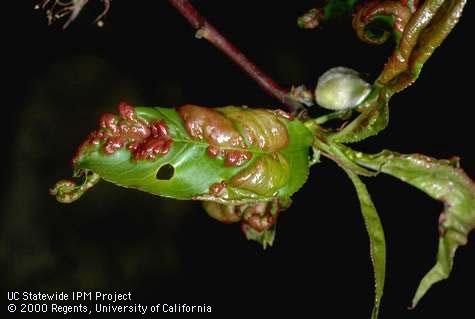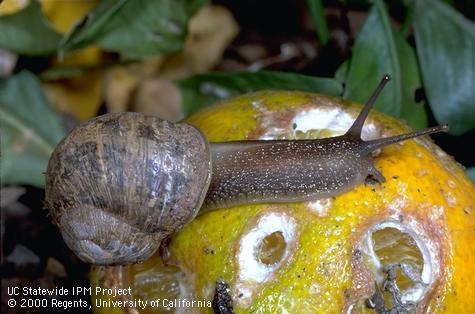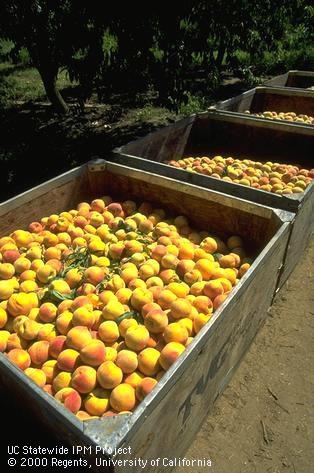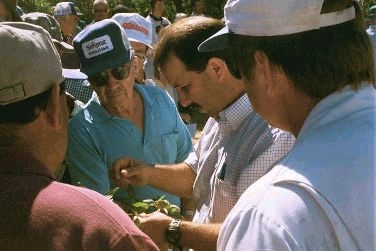
Posts Tagged: cling peaches
Top 10 pests in gardens and landscapes and how to control them
Download the free booklet at the bottom of the page!
1. Ants

Most people deal with ants around their home at some point. Because most ants live outdoors, focus efforts on keeping ants from entering buildings by caulking entryways. Follow good sanitation practices to make your home less attractive to ants. Spraying ants inside the home will not prevent more ants from entering. Use baits to control the ant colony. Pesticide baits work by attracting worker ants who then take the poison back to the nest where the entire colony, including queens, can be killed. In the landscape, ants protect honeydew-producing pest insects from predators, so use sticky barriers or insecticide baits to keep ants out of trees and shrubs.
- Find out more at http://www.ipm.ucanr.edu/QT/antscard.html
2. Aphids

Aphids can curl leaves and produce sticky honeydew, but they rarely kill plants and you usually can wash them off with water. When aphid numbers get high, natural enemies such as lady beetles (lady bugs), lacewings, syrphid fly larvae, soldier beetles and others frequently feed on them, eliminating the need for pesticides. Protect these good bugs by avoiding the use of insecticides that can be toxic to a broad variety of insects. Ants protect aphids from these natural enemies, so keep ants away from your garden as well. When pesticides are necessary, use less toxic products such as insecticidal soaps and oils.
- Learn more about controlling aphids here: http://www.ipm.ucanr.edu/QT/aphidscard.html
3. Asian citrus psyllid and Huanglongbing disease

The Asian citrus psyllid (ACP) and the deadly bacterial disease it spreads, Huanglongbing (HLB), threaten citrus trees in backyards and on farms. There is no cure or effective control method for HLB disease. All types of citrus—including oranges, grapefruit, lemons, and mandarins—are affected as well as a few closely related ornamentals. ACP and HLB have already devastated the Florida citrus industry, and now that it is in the Western U.S. it is threatening the California citrus industry as well.
- See where the outbreaks are in California with our helpful Asian citrus psyllid website: http://ucanr.edu/sites/ACP/Distribution_of_ACP_in_California/
- Contact your agricultural commissioner's office, or call the California Department of Food and Agriculture (CDFA) Exotic Pest Hotline at 1-800-491-1899 to confirm a find. Learn more about ACP here: http://www.ipm.ucanr.edu/QT/asiancitruscard.html
4. Gophers

Gophers are small burrowing rodents that feed on roots of many types of plants. A single gopher can ruin a garden in a short time, and gopher gnawing can damage irrigation lines and sprinkler systems. In lawns, their mounds are unsightly and interfere with mowing. Early detection is critical to prevent damage. Use both traps and underground fencing to manage gopher problems. Toxic baits are available but can pose threats to wildlife, pets, and children, especially in backyard situations.
- Learn more about protecting your garden and landscape from gophers here: http://www.ipm.ucanr.edu/QT/gopherscard.html
5. Leaf-feeding caterpillars

Caterpillars, which are the larvae of butterflies and moths, damage plants by chewing on leaves, flowers, shoots, and fruit. Caterpillars in fruit or wood can be difficult to manage because they are hidden most of their life and can cause serious damage even when numbers are low. However, many plants, especially perennials, can tolerate substantial leaf damage, so a few leaf-feeding caterpillars often aren't a concern. Handpicking and beneficial predators and parasites often provide sufficient control. Look for feeding holes, excrement, webbed or rolled leaves, caterpillars, eggs, and good bugs.
- Learn more here:http://www.ipm.ucanr.edu/QT/lfcaterpillarscard.html
6. Peach leaf curl

Peach leaf curl is a fungal disease that affects only peach and nectarine trees. Distorted, reddened foliage in the spring is a distinctive symptom. New leaves and shoots thicken and pucker and later may die and fall off. An infection that continues untreated for several years can lead to a tree's decline. To prevent peach leaf curl, treat peach and nectarine trees with a copper fungicide every year after leaves fall. After symptoms appear in the spring, any treatment will not be effective. When planting new trees, consider buying peach tree varieties that are resistant to the disease.
- To learn more about preventing peach leaf curl click here: http://www.ipm.ucanr.edu/QT/peachleafcurlcard.html
7. Rats

Rats eat and contaminate food, garden produce, and fruit, and transmit diseases to humans and pets. Manage rats by removing food and shelter, eliminating entryways into buildings, and trapping. Snap traps are the safest, most effective, and most economical way to trap rats. For Norway rats, place traps close to walls, behind objects, in dark corners, and in places where you have found rat droppings. For roof rats, place traps in off-the-ground locations such as ledges, shelves, branches, fences, pipes, or overhead beams. Ensure traps are out of reach of children and pets.
- Learn more about preventing and controlling rats here: http://www.ipm.ucanr.edu/QT/ratscard.html
8. Scales

Scale insects suck plant juices and are pests of many trees and shrubs. Infestations can cause yellowing or premature dropping of leaves, sticky honeydew, and blackish sooty mold. Plant parts can distort or die back, depending on the species and abundance of scales. Most plants tolerate low to moderate numbers of scales. Provide plants with proper cultural care, especially irrigation. Encourage scale predators such as lady beetles or lacewings and look for parasite emergence holes in scale covers. Use sticky barriers or insecticide baits to selectively control scale-tending ants. Consider replacing problem-prone plants because most scales are highly specific to certain plants.
- Learn more about controlling scale populations here: http://www.ipm.ucanr.edu/QT/scalescard.html
9. Snails and slugs

These slimy mollusks emerge from hiding at night and chew holes in leaves and flowers of many succulent garden plants and fruit. Management requires a vigilant and integrated approach that includes eliminating moisture and hiding spots, trapping, setting up barriers, and handpicking. Regularly remove snails from shelters you can't eliminate such as low ledges on fences, undersides of decks, and meter boxes. Place traps in your garden and dispose of trapped snails and slugs daily. Reduce moist surfaces by switching to drip irrigation or watering in the morning rather than later in the day. Consider snail-proof plants such as impatiens, geraniums, begonias, lantana, nasturtiums, and many plants with stiff leaves and highly scented foliage such as sage, rosemary, and lavender.
- Learn more about controlling snails and slugs with and without pesticides in your garden here: http://www.ipm.ucanr.edu/QT/snailsslugscard.html
10. Weeds in landscapes

Prevent weed invasions in new beds with good site preparation. Keep weeds out with an integrated program that includes competitive plants, mulches, and hand removal. Be particularly vigilant about removing aggressive perennial weeds. You rarely should need herbicides in established landscape plantings. Mulches prevent weed seed germination by blocking sunlight. Remove small weeds by hand before they flower and set seed. Use shallow cultivation or hoeing to remove annual weeds from ornamental plantings. Only use herbicides for special-problem situations before establishing new plantings or for difficult-to-control perennial weeds.
- Learn more about controlling weeds in your landscape here: http://www.ipm.ucanr.edu/QT/landscapeweedscard.html
To see all of the University of California's Statewide Integrated Pest Management Program's information on home, garden, and landscape pests, visit http://www.ipm.ucanr.edu/PMG/menu.homegarden.html
For other short pest “Quick Tips” like the ten above, see http://www.ipm.ucanr.edu/QT/
To read even more in-depth, peer-reviewed information on many other common home and landscape pests in California, see the Pest Notes series at http://www.ipm.ucanr.edu/PMG/PESTNOTES/index.html
Download your free UC IPM Quick Tips Booklet of the Top Ten Pests in Gardens and Landscapes and How to Control Them with the link below!
Valley farmers are pulling out peaches

Many environmental factors can significantly compromise a peach harvest, said Maxwell Norton, UC Cooperative Extension advisor in Merced County.
"For tree fruit you need to have a greater net profit than you do raising tree nuts because growing tree fruit is so much more risky," he said. "The biggest risk of all is not being able to find enough labor during harvest. Peaches, when they're ripe, you have very few days to harvest."
In the Northern San Joaquin Valley, including Merced and Stanislaus counties, about 8.2 percent of bearing acres for clingstone peaches, or 667 acres, have been pulled out of production this fall, the article said.
Because trees are being pulled out, processors are beginning to increase the price they are offering.
Delhi farmer Glenn Arnold said he's clinging to peaches for now.
"I was happy when I heard the price because it's a fair price," he said. "A hail storm can take your whole crop in two minutes. If you don't get compensated adequately for the risk, you might switch to an alternative."
Budget cuts felt on agricultural campuses
An article by Ching Lee in today's Ag Alert focused on the effects of budget cuts on agricultural student programs at California universities. "Budget cuts have had a profound effect on all areas of the campus," Diane Ullman, associate dean for undergraduate academic programs at UC Davis College of Agricultural and Environmental Sciences, told the reporter. She explained the college faces challenges keeping agricultural production facilities, instructional equipment and technologies updated to deliver hands-on education — even though the office has seen student applications increase by 70–80 percent.
Tom Baldwin, dean of UC Riverside College of Natural and Agricultural Sciences, also commented on the challenges of serving students in the face of diminishing resources, saying the university is "moving heaven and earth" to do so.
The cuts are being felt at on-campus farms as well. Raoul Adamchak, of the UC Davis Student Farm, explained that the market garden generates its own income and provides a lesson to students on self-sustaining businesses. "Things cost money, and these are part of the expenses of farming, so it has to be factored in. They have to make decisions based on the cost of things and the returns," he said.
Peach association to major retailer: Buy U.S.-grown
Christine Souza, Ag Alert
The California Canning Peach Association has asked Target to consider California fruit for its Market Pantry-brand canned peaches, which are currently a product of China. Wal-Mart carries a comparable product made from California cling peaches, with a lower retail price.
Reporter Christine Souza sought expert commentary from Roberta Cook, UC Cooperative Extension marketing specialist at the Davis campus, on the current market for California cling peaches. "When you are talking about processed items, if another country can produce it a lot cheaper than you, then you will be vulnerable to competition. And consumer preferences have moved towards fresh. So [California cling-peach businesses] are hit by both factors," she told the reporter.
Related ANR News Blog post: Chinese farmers take a bite out of the California cling-peach market

Chinese farmers take a bite out of the California cling-peach market
California cling-peach growers' market dominance is beginning to erode in the face of cheap cling-peach imports from China, according to an article in today's Fresno Bee.
Imports of lower-priced Chinese canned cling-peaches grew from 43,000 cases 10 years ago to more than 2.2 million last year, the article said. Chinese peaches now represent 12 percent of the 16 million cases consumed in the U.S.
To defend their turf, California growers are looking for ways to reduce their production costs. Bee reporter Robert Rodriguez spoke to UC Cooperative Extension farm advisor Roger Duncan about his research with German-made equipment that would cut the cost of spring hand-thinning, a practice that ensures ripe fruit reaches the proper size.
"I am optimistic that growers will take a look at this," Duncan was quoted. "Because it is going to be difficult to compete against a country that can produce a product cheaper than we can.
Mechanical pre-thinning will not replace the hand thinning, but it can reduce the cost -- estimated at about $1,000 an acre -- by 25 to 30 percent.
"We've done lots of studies in California on mechanical and chemical fruit thinning or blossom thinning," Duncan said. "Generally what we see is the earlier you remove those fruit, the larger the remaining fruit are at harvest because there is less competition for nutrients from the mother tree."
In addition to finding efficiencies in their production practices, the cling-peach industry is asking Americans to buy the home-grown product.
"We need to educate consumers that they should be looking for peaches from the U.S.," Reedley farmer Harry Berberian told Rodriguez. "There are a lot of us who have been growing cling peaches for a long time. It's in our blood. And we are going to keep going as long as we can, but it is not going to be easy."
The online version of the Bee story generated many outraged comments from readers, including:
"We used to produce the best peaches in the world, how can we compete with these fellas from China? The folks from this country will work for a few cents a day, they don't complain about the job, and if they do, there's a heck of a lot of Chinese folks that will take their place."
"Who let that happen? We the people want our jobs back that the American government gave to China. It should be economic treason what Wall Street and the government have done!"

UC farm advisor Roger Duncan, center, with a group of California farmers.
